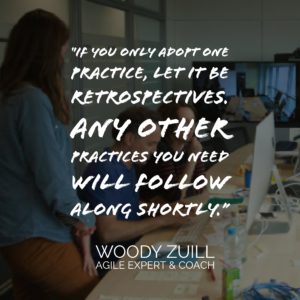We frequently hear that Agile is only a tool for technologists. And, with titles like “The Manifesto for Agile Software Development” floating around, we can see how this is a common misconception. So, for those of you who have asked yourself, “how does Agile apply to me?” we are sharing our perspective and one way you can adopt an Agile practice.
We believe Agile has real applications beyond creating software. At the end of the day, it is just a set of values and principles – it can apply to our lives as any other value, principle or belief.
Can Agile create better ways of living?
Agile is about creating better ways of living – which sounds great but where to start? Organizations like Vistaprint have entire teams dedicated to Agility, so what can I do as an individual?
 Woody Zuill, an Agile expert and key proponent of Mob Programming and #NoEstimates, says, “If you only adopt one practice, let it be Retrospectives. Any other practices you need will follow along shortly.”
Woody Zuill, an Agile expert and key proponent of Mob Programming and #NoEstimates, says, “If you only adopt one practice, let it be Retrospectives. Any other practices you need will follow along shortly.”
So, if we are to assume he’s right and that Retrospectives are the starting point, what exactly are they? And how do we go about applying them? Retrospectives are all about reflecting on past and current behaviors and then seeking opportunities to improve.
There’s nothing mystical about it and you don’t need a special facilitator (or Post-it notes) to do it. All you need is a few minutes to reflect and a commitment to improve.
Retrospectives at the dinner table
Interested in understanding more about how Agile can be applied to our daily lives, we spoke to Daryl Paraguya, Senior Technology Manager, Vistaprint. Interestingly, his family runs weekly Retrospectives over Sunday dinner. “Each family member says something they are grateful for about another family member. Then we talk about what we liked about the last week and what we didn’t.”
Once they reflect on the week, Daryl’s family decides on an action they’ll take to improve. “Sometimes they’re fun and sometimes they’re serious. We’ve made some big changes to bedtime routines, how we allocate chores, and other very tactical things that affect our day to day lives. We probably wouldn’t work the same without these. I’m happy that we do it. It’s changed how we live and how we treat each other.”
Retrospective actions become even more powerful when they’ve been visualized. And, in Daryl’s family, they write down their action each week and put it on a magnet board in the kitchen to remind them all of their commitment.
You might be surprised by what you learn
For Daryl, Retrospectives gave him a new perspective and an opportunity to learn more about his family. “Oftentimes my kids are really thoughtful about their gratitude. They take it very seriously and I love that. Without Retrospectives, I might never have appreciated that my kids have this really mature level of introspection and empathy because we don’t normally talk like that.”
Using retrospectives at home is just one way you can bring Agile into your everyday life. Remember, Agile is about creating better ways of living. Make a commitment to yourself and give retrospectives a try!
Contributed by David Reichert & Melissa Rockman, Agile Coaches in Vistaprint
